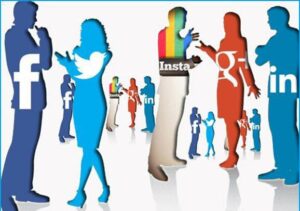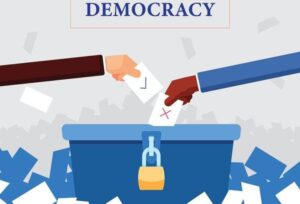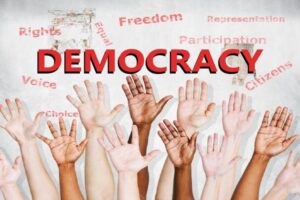
Social media groups can improve voter knowledge, but may also increase polarization in political preferences Democracies around the world are reckoning with the impact of social media on their elections. Nowhere is this more so than in India, the world’s largest democracy. More than 500 million WhatsApp users make the chat-based application India’s most used social media platform. Due to its popularity, WhatsApp has become a common tool for political parties and politicians to reach voters. Despite widespread concern about the role of social media in elections, little evidence exists on how platforms like WhatsApp influence the democratic process.
At its advent, social media seemed a promising way for people to connect and keep up with the world around them. Development economics research demonstrates that voter information is an important input into the democratic process (Pande 2011). But over time, social media has been characterized by low-quality and ideologically segregated information, resulting in concerns about misinformation and polarization (Guriev et al. 2021).
Comparing social and traditional media
To study the effects of social media, it is useful to understand how it compares to traditional media. Social media differs from traditional media in that it allows users to engage in ‘horizontal communication’ – the two-way information transmission between individuals (Zhuravskaya et al. 2020). Traditional media consists primarily of ‘vertical communication’ — where content disseminates from a common source without interaction. By contrast, social media features both vertical and horizontal communication.
Political parties and politicians around the world have begun to use WhatsApp as a means of broadcasting their messages to voters. Parties often use a strategy of creating thousands of localized WhatsApp groups, which have a maximum of 256 members each, to reach voters. In contrast to traditional political advertisements, individuals in these WhatsApp groups can also reply and post themselves. In this way, political WhatsApp groups typically feature both vertical communication directly from the organizing political party, but also horizontal communication between individual group members.
To understand how political WhatsApp groups influence voters, I conducted a study in the month before a large state-wide election in Tamil Nadu, India (Carney 2022). I designed an experiment to answer two central questions. First, how do political groups on WhatsApp
influence outcomes like polarisation and belief in misinformation? Second, how do these political groups on social media work: are their effects on voters driven by the vertical messaging directly from the party, or by the horizontal messaging between individuals? To put
this second question differently, the research aimed to study whether social media functions simply as a new tool of mass media for parties to reach larger numbers of voters at low cost, or whether the interpersonal communication between users drives its effects.

The effects of the groups
The first outcome from the endline survey is political knowledge. Participants took a quiz where they saw a series of true and false headlines and were asked to assess the truthfulness of each. Comparing treated and control participants shows that the WhatsApp groups improved voter knowledge, causing group members to be better able to identify true and false news. In view of recent concerns about social media’s role in spreading political misinformation, this result is strikingly positive.
The second outcome the study examines is political preferences. To estimate the effects of the groups on political polarisation, participants answered questions about their views of parties, politicians, and policies in the endline survey. These answers were combined into a series of
indices. Comparing treated and control participants reveals that the WhatsApp groups increased participants’ rating of the party organizing the group by a small, yet statistically significant margin. This increase comes primarily from political moderates, who were indifferent
between parties at the baseline but slightly preferred the party whose group they joined by the endline survey. Importantly, the study finds no evidence that the groups influenced measures of affective polarisation — people’s negative feelings toward their political opponents. This
contrasts research on the effects of social media in other contexts, such as the United States. (Iyengar and Krupenkin 2018, Levy 2021).
Vertical versus horizontal communication
What drives the effects of these groups? Looking at participants who were only exposed to horizontal, party communication shows that the peer-to-peer vertical communication in the full groups played an important role. Across all primary outcomes, the treatment effect of the
groups with only direct party messaging are smaller in magnitude and less statistically significant than the effects of the full groups that included peer-to-peer vertical communication. This demonstrates that the definitional element of social media — the peer-to-peer, horizontal
communication it facilitates — is central to the effect these WhatsApp groups have on their members.
Misinformation and Fake News
One of the most significant challenges posed by social media is the spread of misinformation and fake news. The rapid dissemination of false information can influence public opinion and undermine trust in democratic institutions. Recent elections worldwide have seen the proliferation of misleading information, sometimes fueled by malicious actors seeking to sway electoral outcomes.

Polarization and Echo Chambers
Social media algorithms often create echo chambers, where users are exposed primarily to information that aligns with their existing beliefs. This can lead to increased polarization and a fractured public discourse. When individuals are isolated in ideological bubbles, it becomes
more challenging to find common ground and engage in constructive dialogue.
Regulation and Policy
The impact of social media on democracy has prompted calls for regulation and policy changes. Governments and organizations are grappling with how to address issues like privacy, content moderation, and platform accountability. The balance between protecting free speech and preventing harm is a critical and ongoing debate in the realm of digital governance Social media itself is neither inherently good nor bad for democracy, but it can be either depending on who is using it and for what ends. When social media first burst onto the political
scene about a decade ago, it was hailed as “liberation technology” that would spread democracy around the globe. People who did not have access to mainstream media could coordinate and collaborate with one another outside the control of an authoritarian state.
Of course authoritarian regimes eventually woke up to the threat posed by pro-democracy online opposition, and developed a suite of tools to confront this, including offline responses (e.g., imprisoning bloggers, changing liability laws), restricting access to online content (e.g., the
great firewall of China), or trying to influence the online conversation. This last response option led to the development of political bots and trolls.
Ironically, the very same affordances that made social media useful for pro-democracy activists also make it a valuable tool for those who harbor anti-democratic sentiments in democratic societies. Prior to social media, if you were the only one in your county who supported extremist views regarding the overthrow of the United States government, organizing with other likeminded but geographically dispersed compatriots would be a costly activity. Social media drastically reduces these costs and allows such individuals to more easily find each other
to organize and collaborate. Moreover, the tools developed by authoritarian regimes to influence their own online conversations — online trolls and bots — can also be used by small numbers of extremists in democratic societies to amplify their presence online, making their
positions appear to be more popular than they might be.
Another liability of social media for democratic societies is that it exacerbates a trend that was already developing on the Internet before the arrival of social media, which is the removal of traditional gatekeepers from the production and distribution of “news.” Prior to the Internet,
news was in the domain of professional journalists and there were powerful gatekeepers in the form of editors and publishers. While this may have also prevented more progressive messages from entering mainstream media, it undoubtedly also blocked extreme anti-democratic voices as well, in addition to enforcing a certain level of quality in news reporting. The Internet lowered the barrier to publishing news dramatically, but social media accelerated this process.
Social media exacerbated the premium placed on news that delivered “clicks,” highlighting the appeal of certain types of news — including blatantly false news — with particular features, including appealing to partisan identity.
When we turn to more specific accusations, however, such as whether social media is exacerbating political polarization, the picture is a lot less clear. There are theoretical reasons to think that social media could exacerbate political polarization by placing people in echo chambers where they are surrounded by likeminded fellow partisans who denigrate those on the opposite side of the political spectrum. But the evidence for the existence of echo chambers is much more mixed than most people assume, and there are reasons to think that social media actually exposes us to more people with diverse political views than we encounter offline.
There are also reasons to think that social media may privilege the type of news that leads to people becoming more politically polarized, and a recent study demonstrated that taking people off of social media for a month did show lower levels of dislike for out-partisans in the U.S. However, in new, under review, research from the NYU Center for Social Media and Politics, we find that taking people off of social media at a politically fraught time in Bosnia-Herzegovina actually increases ethnic out-group hostility, and that this effect is largely driven by people who live in ethnically homogenous areas of the country. This suggests that for some people, their online connections may actually expose them to a greater diversity of views than they encounter offline in the course of their daily life.
If we look over time, it is clear that political polarization has increased both in the U.S. and globally over the past decade, a time period that coincides with the rise of social media. But there are a lot of other things that have occurred in that time period, including globalization,
economic stagnation in the aftermath of the Great Recession, the Syrian crisis and resulting refugee flows in Europe, rising polarization in the United States, a renewed awakening around issues of social and racial justice, and, most recently, a global pandemic. We need to be careful about assuming correlation equals causation in the case of social media — it may very well be the case that political polarization, particularly in the United States, would have been growing in response to long-term economic and demographic developments even absent the dramatic technological changes that have taken place at the same time.
Social media platforms like Instagram and Facebook have become ingrained in the lives of countless individuals. With adolescents and young adults, particularly young women, being the primary users of such platforms, it is an important question whether social media use has an
impact on self-concept, self-esteem, body image, and body dissatisfaction. Researchers have started to empirically investigate these questions, and recent studies show mixed results. The present article attempts to review these findings and offers possible explanations for effects of social media use on body dissatisfaction, with a focus on Instagram, Facebook, and other popular image-based platforms.
usage in particular has increased dramatically over the last decade and continues at an incline. Pew Research Center indicates that 71% of 13- to 17-year-olds use Facebook, 52% use Instagram, and 41% use Snapchat in 2015. Teenage girls are also using image-based social media platforms more frequently than their male counterparts; 61% of girls use Instagram versus 44% of boys. This increase in usage of social media, especially Facebook and Instagram, may negatively affect adolescent girls and young women in regard to their self-confidence and body satisfaction (Lenhart, 2015).

Some researchers have portrayed links between body dissatisfaction and eating disorders with exposure to fashion magazines or television shows in women (Grabe et al., 2008; Levine & Murnen, 2009). These studies examined exposure to media forms and body image to show that there may be a link between viewing images of thin bodies and personal body dissatisfaction. Another study by Becker and colleagues (2011) suggests that media effects can even take place indirectly. The authors studied whether direct and indirect exposure to mass media (i.e., television, videos, CD players, MP3 players, internet access, mobile phone access) were associated with eating pathology in Fijian adolescent girls. They found relationships between both direct mass media exposure (i.e., personal media exposure) and indirect mass media
exposure (i.e., media exposure to the people in one’s peer group) with eating pathology in Fijian adolescent girls. Despite its limitations, such as the question of whether the findings can be generalized (Becker et al, 2011), the study suggests that at least in this case,social networks
played an important role in the relationship between media and eating pathology, which may extend to a relationship between media and body dissatisfaction.
However, these findings must be taken with knowledge that some other researchers have found no link between viewing image based media and body dissatisfaction. Holmstrom (2004) conducted a meta-analysis on the pre-existing literature focusing on general media exposure
and body dissatisfaction, body image and eating disorder pathology. Holmstrom focused on 34 studies that used media as the independent variable and a form of body image dissatisfaction as the dependent variable and the overall effect size was small. Surprisingly, the research showed that women reported feeling better about their bodies after viewing overweight images and had no change in body image after viewing thin bodies. These findings blur the potential relationship between body image and media and suggest a need to further investigate.
A more recent meta-analysis conducted by Ferguson (2013) extended the work of Holmstrom (2004), Grabe and colleagues (2008) and other researchers, and incorporated findings from 204 studies. A major point that Ferguson honed in on was publication bias; more specifically, that statistically significant results are more likely to be published and null findings are not, with meta-analyses being a collection of biased findings. Ferguson (2013) found little to no relationship between media and body dissatisfaction in males, however, there was a higher, but
very small, prevalence in females, especially for those with a predisposition for body image issues. Overall, the meta-analysis encouraged researchers to be more conservative in their assertions of a relationship between social media and body dissatisfaction due to inflated effect sizes, study design limitations, and publication bias.

Social Media Usage
Social media offers a collaborative space for social interaction between seemingly infinite numbers of people. Several benefits have been identified in relation to the routine use of social media platforms. “The six key overarching benefits were identified as (1) increased interactions with others, (2) more available, shared, and tailored information, (3) increased accessibility and widening access to health information, (4) peer, social, emotional support, (5) public health surveillance, and (6) potential to influence health policy” (Moorhead et al., 2013, p. 8). Although there are several benefits associated with the use of social media, specifically image based social media, some uses of these platforms may lead to potentially unwanted effects. The primary image based social media platforms this review examines are Pinterest, Instagram and Facebook.
Lewallen and Behm-Morawitz (2016) suggest that adolescent girls and young women following fitness boards on Pinterest were more likely to report intentions to engage in extreme weight loss behaviors, such as crash dieting or a radical exercise plan. In response to images viewed on the fitness boards on Pinterest, these adolescent girls and young women initiated a process of self-reflection, which increased intention to engage in extreme weight-loss behaviors. Overall, the results of this study revealed that social media environments might influence adolescent girls and young women to engage in social comparison leading to feelings of inadequacy and body dissatisfaction (Alperstein, 2015). Furthermore, based on the results of this study and others, negative body image concerns appear to be higher for those who internalized negative messages and images (Alperstein, 2015; Bell, 2016).
Currently, studies link social media platforms with body dissatisfaction in adolescent girls (Tiggemann & Miller, 2010; Tiggemann & Slater, 2013). In order to investigate the underlying processes, one study investigated over 100 seventh graders and found that adolescent girls who
shared more photos online, such as selfies, and used more photoshop felt worse about their appearance and exhibited greater eating concerns (McLean et al., 2015). Specifically, some studies suggest greater usage of social media heighten body dissatisfaction due to an increase in appearance-related comments from friends (de Vries et al., 2015).
Using applications and other editing devices, such as Photoshop, to alter selfies is nothing new for many teens and women. Thanks to an array of free applications, people can alter the way their bodies look in photos with a swipe or a click. Teens can cover up blemishes, alter their facial shape, and manipulate their bodies to look thinner and more attractive (e.g., making their waists smaller or their breasts bigger). Even the popular socialites Kim and Khloe Kardashian have utilized Photoshop to post edited selfies for their Instagram accounts. As pointed out in an article by Mirror Magazine, many fans have criticized the sisters for unrealistic alterations to make themselves look thinner and more toned (Rutter & Strang, 2016).
Instagram and Body Dissatisfaction
Instagram is one of the most popular social media platforms (Kharpal, 2015). It allows users to communicate solely through posting and sharing photos. Researchers have looked at the role of Instagram on body image with adolescent girls and young women, the most frequent users of the social media platform. Anecdotally, in an interview with Elle Magazine, Emily Bryngelson, an associate designer at Ann Taylor, who admitted to struggling with an eating disorder as a teenager, revealed that she deletes selfies if she doesn’t receive enough “likes” (Fleming, 2014). She explains, “Instagram makes me so anxious. I’m always looking at other women thinking, ‘I wish I looked like that,’ or ‘I should get more in shape.’…I mean, young girls can now follow Victoria’s Secret models and see what they look like in the ‘every day.’ …That has got to make any woman, let alone a 13-year-old girl, feel unsure of herself.”
Studies on Instagram have mostly focused on fitspiration pictures and content in the young adult population. Fitspiration is a movement that promotes a healthy lifestyle, primarily through food and exercise. Despite its good intentions, researchers have suggested dysfunctional
themes in the images and messages. For instance, when over 600 fitspiration images were studied, one major theme regarding the female body emerged: thin and toned (Tiggemann & Zaccardo, 2016). In addition, most images were found to contain elements objectifying the
female body. However, we must wonder whether the blogs themselves are problematic or if the viewers are construing the content in a negative way. In other words, are certain individuals viewing a toned or thin body, comparing themselves to it, and then feeling bad about their own body?
Furthermore, some researchers suggest that even the mere act of watching fitspiration on Instagram can lead to unhealthy eating and exercise behaviors in young adults (Holland & Tiggemann, 2016). In one experiment where 130 female undergraduates were randomly
exposed to either fitspiration or neutral travel images, scientists found that the appearance based pictures of fitspiration had a negative impact on mood, body image, and self esteem (Tiggemann & Zaccardo, 2015). In other words, the college students who viewed fitspiration images felt worse about themselves and their bodies compared to the students who viewed neutral images. Limitations of these studies need to be kept in mind when interpreting the findings. Using travel photos as a control to fitspiration may not have isolated the variable of
interest and resulted in inaccurate findings. We expect humans to socially compare themselves to other humans more than they do with landscape. Future studies should consider incorporating control photos featuring attractive, but average-sized women, for example, to
produce more comparable results.
The intersection of social media and democracy presents both opportunities and challenges. While these platforms have the potential to enhance political participation and amplify marginalized voices, they also pose risks related to misinformation, polarization, and regulatory
concerns. As we continue to navigate the digital age, it is crucial for citizens, policymakers, and tech companies to work collaboratively to address these challenges and ensure that social media supports, rather than undermines, democratic values.


